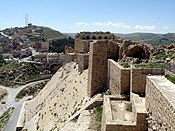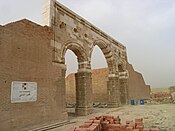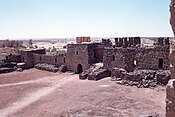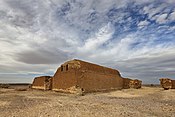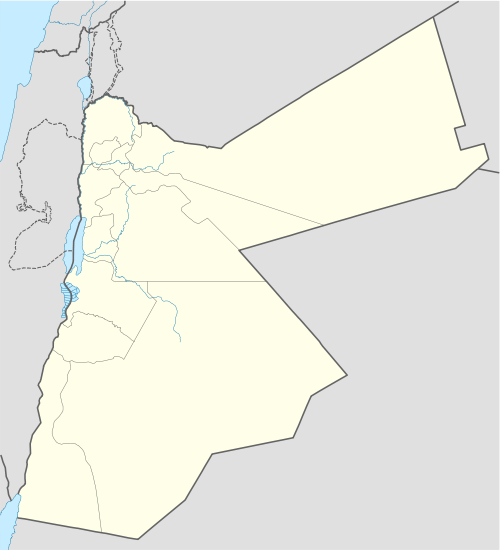
Qusayr 'Amra or Quseir Amra, lit. "small qasr of 'Amra", sometimes also named Qasr Amra, is the best-known of the desert castles located in present-day eastern Jordan. It was built some time between 723 and 743, by Walid Ibn Yazid, the future Umayyad caliph Walid II, whose dominance of the region was rising at the time. It is considered one of the most important examples of early Islamic art and architecture.

Zarqa Governorate is the third largest governorate in Jordan by population. The capital of Zarqa governorate is Zarqa City, which is the largest city in the governorate. It is located 25 kilometres (16 mi) east of the Jordanian capital Amman. The second largest city in the governorate is Russeifa.
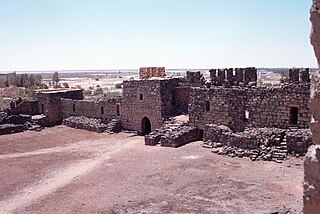
Qasr al-Azraq is a large fortress located in present-day eastern Jordan. It is one of the desert castles, located on the outskirts of present-day Azraq, roughly 100 km (62 mi) east of Amman.
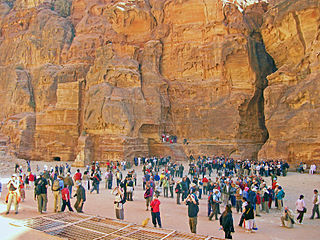
Jordan is a sovereign Arab state in the Middle East. The capital, Amman, is Jordan's most populous city as well as the country's economic, political and cultural centre.
The desert castles or qasrs are often called Umayyad desert castles, since the vast majority of these fortified palaces or castles were built by the Umayyad Dynasty in their province of Bilad ash-Sham, with very few Abbasid exceptions. The desert castles of Jordan represent a prominent part of this group of buildings, with most Umayyad "desert castles" being scattered over the semi-arid regions of north-eastern Jordan, with several more in Syria, Israel and the West Bank (Palestine), and just one Abbasid exception in Iraq.

Jordanian art has a very ancient history. Some of the earliest figurines, found at Aïn Ghazal, near Amman, have been dated to the Neolithic period. A distinct Jordanian aesthetic in art and architecture emerged as part of a broader Islamic art tradition which flourished from the 7th-century. Traditional art and craft is vested in material culture including mosaics, ceramics, weaving, silver work, music, glass-blowing and calligraphy. The rise of colonialism in North Africa and the Middle East, led to a dilution of traditional aesthetics. In the early 20th-century, following the creation of the independent nation of Jordan, a contemporary Jordanian art movement emerged and began to search for a distinctly Jordanian art aesthetic that combined both tradition and contemporary art forms.

Qasr al-Hayr al-Gharbi is a Syrian desert castle or qasr located 80 km south-west of Palmyra on the Damascus road. The castle is a twin palace of Qasr al-Hayr al-Sharqi, built by the Umayyad caliph Hisham ibn Abd al-Malik in 727 CE. It was built in the Umayyad architectural style.

Al-Muwaqqar is a district in the Amman Governorate of north-western Jordan. The village contains the scant ruins of an Umayyad palace, the Qasr al-Muwaqqar, one of the desert castles. Little remains of the palace today except several acanthus leaf capitals and gauge of a water reservoir.

Qasr al-Hallabat is an Umayyad desert castle, with the associated bath house of Hammam as-Sarah east of it. The nearby modern town, named after the castle, is part of the Zarqa Governorate of north-western Jordan, north-east of the capital of Amman.

Hammam al-Sarah is an Umayyad bathhouse (hammam) in Jordan, built in connection with the complex of Qasr al-Hallabat, which stands some 2 kilometres (1.2 mi) to the west. Along with examples in the other desert castles of Jordan, it is one of the oldest surviving remains of a Muslim bathhouse.
Qasr Tuba is an 8th-century Umayyad qasr or castle in the Amman Governorate of northern Jordan.

The Aqaba Castle or Aqaba Fort, also known as the Mamluk Castle of Aqaba, Jordan, is a Mamluk and Ottoman fortified caravanserai on the pilgrimage route to Mecca and Medina which, in its current form, dates back mainly to the 16th century. In the century preceding the First World War, it was used to a larger degree as a military stronghold.
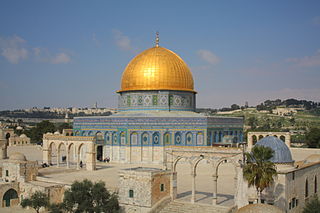
Umayyad architecture developed in the Umayyad Caliphate between 661 and 750, primarily in its heartlands of Syria and Palestine. It drew extensively on the architecture of older Middle Eastern and Mediterranean civilizations including the Sassanian Empire and Byzantine Empire, but introduced innovations in decoration and form. Under Umayyad patronage, Islamic architecture began to mature and acquire traditions of its own, such as the introduction of mihrabs to mosques, a trend towards aniconism in decoration, and a greater sense of scale and monumentality compared to previous Islamic buildings. The most important examples of Umayyad architecture are concentrated in the capital of Damascus and the Greater Syria region, including the Dome of the Rock, the Great Mosque of Damascus, and secular buildings such as the Mshatta Palace and Qusayr 'Amra.

The Painting of the Six Kings is a fresco found on the wall of Qasr Amra, a desert castle of the Umayyad Caliphate located in modern-day Jordan. It depicts six rulers standing in two rows of three. Four of the six have inscriptions in Arabic and Greek identifying them as the Byzantine emperor, King Roderic of Spain, the Sasanian emperor, and the King of Aksum. The painting, now substantially damaged, is thought to be from between 710 and 750, commissioned by the Umayyad caliph or someone in his family. It is one of the most famous frescoes in the Qasr Amra complex.

Alphons Leopold Mielich was an Austrian painter noted for his orientalist scenes. He participated in a team responsible for documenting the frescoes in an Umayyad castle at Qasr Amra, including the famous Painting of the Six Kings and provided the illustrations for a published book on the findings, Kusejr 'Amra, published in 1907. He is also responsible for the destruction of most of the Painting of the Six Kings, as it was severely damaged when he attempted to forcibly relocate the paintings to Germany.

Qasr Burqu' is a set of ruins and an archaeological site in the badia of eastern Jordan and is the site of one of the earliest of the Umayyad desert castles.
Humayma also spelled Humeima and Humaima, is the modern name of ancient Hawara. Hawara was a trading post in southern Jordan that was founded by the Nabataean king Aretas III in the early first century BC. It is located 45 km to the south of the Nabataean capital Petra and 55 km to the north of the Red Sea port town of Aqaba.
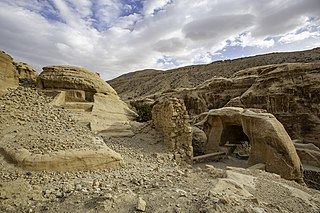
Wu'ayra Castle is a ruined Crusader castle located in Wadi Musa, Jordan, 1 kilometre (0.62 mi) north of the main entrance to Petra. It was founded by Baldwin I of Jerusalem as an outpost of the larger Montreal Castle, which stands about 34 kilometres (21 mi) north of it at Shoubak. The area is extremely rugged and difficult to access. The site rises about 1,050 metres (3,440 ft) above sea level and is surrounded by a natural valley.
Qasr Bayir is a desert castle built in 743 CE by Prince Walid bin Yazid. It is found in the desert of Jordan and it was destroyed in 1931.


